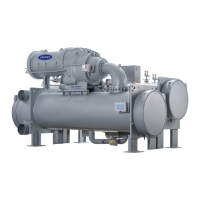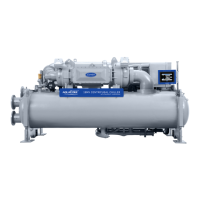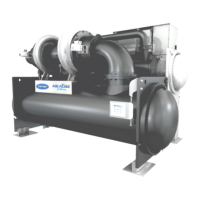15
Shutdown — The unit can be stopped locally using the
HMI by pressing the green Start/Stop icon . The Unit Start/
Stop screen is displayed. Press Confirm Stop (see Fig. 14).
Fig. 14 — Confirm Stop
Chiller shutdown begins if any of the following occurs:
• Local OFF button is pressed
• A recycle condition is present
• The time schedule has gone into unoccupied mode when
in Network or Local Schedule control mode
• The chiller protective limit has been reached and chiller
is in alarm
• The start/stop status (CHIL_S_S) is overridden to stop
from the network when in Network mode
If the chiller is normally shut down from running, soft stop
shutdown will be performed. The soft stop feature closes the
guide vanes of the compressor automatically if a non-alarm
stop signal occurs before the compressor motor is de-energized.
Any time the compressor is directed to stop (except in the
cases of a fault shutdown), the guide vanes are directed to close
and VFD is directed to minimum speed for variable speed
compressor, and the compressor shuts off when any of the fol-
lowing is true:
• PERCENT LOAD CURRENT (%) drops below the
SOFT STOP AMPS THRESHOLD
• ACTUAL GUIDE VANE OPENING drops below 4%
• 4 minutes have elapsed after initializing stop.
When any one of the above conditions is true, the shutdown
sequence stops the compressor by deactivating the compressor
start relay. Then the guide vane shall be closed and stay at the
fully closed position, the refrigerant pump relay will be turned
off after 120 seconds post lube, and the chilled water/brine
pump and condenser water pump will be shut down.
BEFORE INITIAL START-UP
Job Data Required
• list of applicable design temperatures and pressures
(product data submittal)
• chiller certified prints
• VFD details and wiring diagrams
• diagrams and instructions for special controls or options
• 19DV Installation Instructions
Equipment Required
• hose and container/injector tool with one end capable of
connecting to
1
/
2
-in. female NPT evaporator charging
valve (for Carrier Inhibitor injection)
• mechanic’s tools (refrigeration)
• digital volt-ohmmeter (DVM)
• true RMS (root mean square) digital multimeter with
clamp-on current probe or true RMS digital clamp-on
ammeter rated for at least 480 vac
• electronic leak detector
• absolute pressure manometer or electronic micron gage
(see Fig. 15)
• drum charging valve (unless refrigerant bottles already
have charging valves)
• charging hose
Fig. 15 — Digital Vacuum Gage
Remove Shipping Packaging — Remove any pack-
aging material from the unit, VFD, and control panels.
Tighten All Gasketed Joints — Gaskets normally
relax by the time the chiller arrives at the jobsite. Tighten all
gasketed joints to ensure a leak-tight chiller (does not apply to
refrigerant joints covered by factory insulation). Gasketed
joints (excluding O-rings) may include joints at some or all of
the following:
• Waterbox covers
• Compressor first suction elbow flanges (at compressor
and at the cooler)
• Compressor secondary suction flanges (at compressor
and low side float chamber)
• Compressor discharge flange
• Cooler inlet line spacer (both sides)
• Envelope control flange (both sides of valve)
• ICP piping flange
• High and low side float chamber covers
See Tables 3 and 4 for bolt torque requirements.
Check Chiller Tightness — Figure 16 outlines the
proper sequence and procedures for leak testing.
The 19DV chillers are shipped without the refrigerant
charge. The chiller is shipped with a 15 psig (103 kPa) dry
nitrogen-holding charge.
If the 15 psig factory nitrogen charge is present, then re-
lease pressure and proceed to pull a deep vacuum on the unit.
Vacuum should be pulled through 1
1
/
2
-in. female NPT located
under bottom of first stage side of the evaporator. Upon com-
pletion of pulling the required vacuum the chiller can be
charged with refrigerant. The
1
/
2
-in. charging valve on top of
the evaporator shell should be used for charging by lifting
charge cylinder and gravity feed into the evaporator. The
chiller should be charged with refrigerant. If the holding
charge is not present, the chiller must be examined for leaks.
To test for leaks add a small refrigerant holding charge to unit
and pressurize with nitrogen up to 20 psig to determine and
correct the origin of the leak. Use an electronic leak detector
to check all flanges and solder joints after the chiller is pres-
surized. If the 15 psig factory nitrogen charge is present, then
release pressure and proceed to pull a vacuum on the unit.

